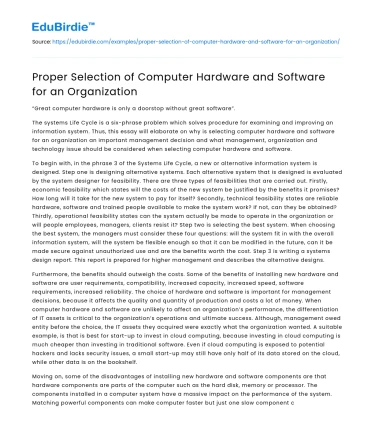“Great computer hardware is only a doorstop without great software”.
The systems Life Cycle is a six-phrase problem which solves procedure for examining and improving an information system. Thus, this essay will elaborate on why is selecting computer hardware and software for an organization an important management decision and what management, organization and technology issue should be considered when selecting computer hardware and software.
Save your time!
We can take care of your essay
- Proper editing and formatting
- Free revision, title page, and bibliography
- Flexible prices and money-back guarantee
To begin with, in the phrase 3 of the Systems Life Cycle, a new or alternative information system is designed. Step one is designing alternative systems. Each alternative system that is designed is evaluated by the system designer for feasibility. There are three types of feasibilities that are carried out. Firstly, economic feasibility which states will the costs of the new system be justified by the benefits it promises? How long will it take for the new system to pay for itself? Secondly, technical feasibility states are reliable hardware, software and trained people available to make the system work? If not, can they be obtained? Thirdly, operational feasibility states can the system actually be made to operate in the organization or will people employees, managers, clients resist it? Step two is selecting the best system. When choosing the best system, the managers must consider these four questions: will the system fit in with the overall information system, will the system be flexible enough so that it can be modified in the future, can it be made secure against unauthorized use and are the benefits worth the cost. Step 3 is writing a systems design report. This report is prepared for higher management and describes the alternative designs.
Furthermore, the benefits should outweigh the costs. Some of the benefits of installing new hardware and software are user requirements, compatibility, increased capacity, increased speed, software requirements, increased reliability. The choice of hardware and software is important for management decisions, because it affects the quality and quantity of production and costs a lot of money. When computer hardware and software are unlikely to affect an organization’s performance, the differentiation of IT assets is critical to the organization’s operations and ultimate success. Although, management owed entity before the choice, the IT assets they acquired were exactly what the organization wanted. A suitable example, is that is best for start-up to invest in cloud computing, because investing in cloud computing is much cheaper than investing in traditional software. Even if cloud computing is exposed to potential hackers and lacks security issues, a small start-up may still have only half of its data stored on the cloud, while other data is on the bookshelf.
Moving on, some of the disadvantages of installing new hardware and software components are that hardware components are parts of the computer such as the hard disk, memory or processor. The components installed in a computer system have a massive impact on the performance of the system. Matching powerful components can make computer faster but just one slow component can ruin the overall performance. Powerful, newly developed components are expensive, so there is always a need to balance performance and cost.
Moreover, in the phrase four of the Systems Life Cycle, new hardware and software are developed, acquired and tested. Step one is acquiring software, the application software for the new information system can be obtained in two ways: it can be purchased as off the shelf package software and, if possible, modify it. It can be custom designed that is it is written by the programmer. Step two is acquiring hardware, the new equipment needed for the information system and locations at which they have to be installed must be determined. Switching or upgrading equipment can be very expensive. Questions that may rise when acquiring hardware: will a personal computer system be sufficient as the company grows? Are networks expandable? Will people have to undergo costly training? Step three is testing the new system. After the software and new equipment have been installed, the system should be tested. Sample data is fed into the system, the processed information is then evaluated to see if the results are correct. Testing may take several months if the new system is complex.
In addition, when choosing computer hardware and software, management, organization and technical factors must be considered. There must be a good reason for an organization to spend money on installing new hardware components and software. Reasons includes: routine maintenance where old hardware is replaced before it wears out or breaks down. Secondly, fault repair, if the equipment develops a fault or breaks down, it needs to be repaired or replaced. Thirdly, upgrade, an upgrade is when a component is installed into a computer system to improve performance. For larger companies, smaller firms can use simple spreadsheets for administration, and most require more specific software to manage the company. They must consider their business strategy and market demand for services to demonstrate that they will be close to their goals and the need to invest in information systems. They also need to consider which departments will need which software and whether the cost is reasonable. They should also consider competing companies.
To conclude, it is evident from the above that managers need good reasons and factors to install the new hardware and software components. The reasons should encounter routine maintenance, fault repair and upgrade. Some of the advantages are increased speed, increased capacity and compatibility. Some of the disadvantages are it can have massive impact on the overall system and there is always a need to balance performance and cost.






 Stuck on your essay?
Stuck on your essay?

